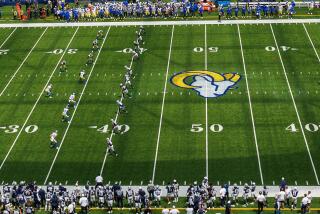Heads-up for dangerous football hits, athletic trainers warn
- Share via
On football fields across the country, the sweating, grunting and hitting of pre-season practice is in full swing, and the nation’s athletic trainers are warning that there’s still too much head-to-head contact in the game -- and with it, potentially catastrophic danger to the head, neck and spine.
On Tuesday, the National Athletics Trainers’ Assn. declared that while professional, collegiate and high school football organizations have done a “commendable job” crafting rules against dangerous head-first hits, “enforcement of these rules regrettably is uneven and infrequent.”
If the hits that paralyze an average of eight to 14 high school and college athletes per year are to be driven from the game, the athletic trainers warned, coaches are going to have to step up their efforts to discourage them and league officials are going to have to call them and penalize them more often.
“Spearing” has been a penalty in high school and National Collegiate Athletic Assn. (NCAA) football since the mid-1970s. As evidence of the dangers of the practice have mounted, the National Football League in 2010 updated and tightened its rules against head-first contact.
But Jonathan F. Heck, director of athletic operations at Richard Stockton College in Pomona, N.J., said in an interview that, in the NCAA, only about 125 penalties were called last year on top-of-the-head hits. That’s up from 20 to 40 per season in Division 1 college play in the years leading up to 2007. But those calls do not capture the widespread practice of players engaging other players with the crown of their helmets in a bid to take them down.
The practice is plenty dangerous to the person receiving such a hit. But it’s by far most dangerous to the player doling it out. Between 2010 and 2012, there were 34 sports-related catastrophic injuries to high school and college athletes’ necks and spines, and nine fatalities. While football helmets provide some protection against blunt-trauma injury, they don’t prevent concussion and don’t protect the spine from compression when a player uses his head as a weapon, the athletic trainers warned.
There are an estimated 3.8 million sports-related concussions per year in the United States among children and adults. But in recent years, concussion-related visits to hospital emergency departments have surged among athletes under 14.
Still, the crunch of colliding helmets has long been the soundtrack to football at all levels, and until players hear from their coaches that the practice is unsafe and illegal -- and until they routinely get penalized for running into other players with their heads down -- younger players won’t stop the practice, Heck said.
The rules prohibiting such contact “must be taken seriously, implemented vigorously and adhered to at every level of play,” he said. “It can be a matter of life and death or other possible catastrophic outcomes,” he added.







